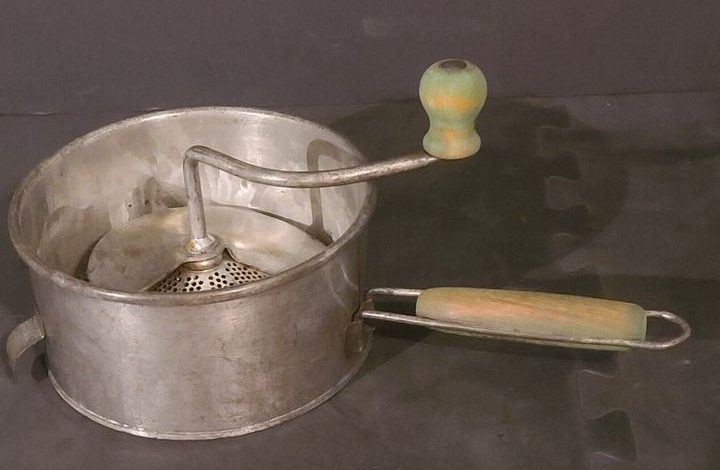The Vintage Food Mill: A Testament to Simplicity and Utility

ADVERTISEMENT
The Vintage Food Mill: A Testament to Simplicity and Utility
In an age where kitchen gadgets are often powered by electricity and boast the latest technology, the vintage food mill stands out as a symbol of simplicity and practicality. This hand-cranked device, often made of metal with a perforated bottom and a rotating blade, was a staple in many kitchens for decades, used for everything from mashing potatoes to making purees and sauces.
A Tool Rooted in Tradition
The food mill, sometimes referred to as a “mouli” or “passoire à légumes,” has its roots in European kitchens where it was an essential tool for processing fruits and vegetables. Its design is straightforward yet effective: as the handle is turned, the blade forces the food through the perforated disk at the bottom, creating a smooth and uniform texture. This method allowed home cooks to create silky mashed potatoes, smooth applesauce, and perfect tomato sauces without the need for electricity or complex machinery.
In many ways, the food mill represents a time when cooking was a more hands-on, labor-intensive process. It required a certain level of skill and patience, but the results were often more rewarding. The tactile experience of using a food mill—feeling the resistance of the food, hearing the soft grind as it passed through the mill—connected cooks to the food they were preparing in a way that modern appliances sometimes fail to do.
The Enduring Appeal of Simplicity
ADVERTISEMENT
Despite the advances in kitchen technology, the food mill has never completely disappeared. In fact, many chefs and home cooks continue to use it today, not out of necessity, but out of preference. The food mill’s ability to produce a texture that is both smooth and substantial is something that even the most advanced blenders and processors often cannot replicate.
Moreover, the food mill’s simplicity is its strength. With no electronic parts or complicated mechanisms, it is easy to use, easy to clean, and incredibly durable. Many vintage food mills, like the one in the image, have been passed down through generations, still functioning as well as they did when they were first purchased. This durability and reliability are rare in modern kitchen tools, making the food mill a cherished item in many kitchens.
A Tool for the Slow Food Movement
In recent years, the rise of the slow food movement has brought a renewed appreciation for traditional cooking methods, and the food mill fits perfectly into this philosophy. The slow food movement emphasizes the importance of taking time to prepare food, valuing quality and craftsmanship over convenience and speed. The food mill embodies this approach, encouraging cooks to slow down and engage more deeply with the process of preparing food.
Using a food mill can be a meditative experience, offering a break from the fast-paced, high-tech world we live in. It reminds us that sometimes, the best tools are the simplest ones—those that require a bit of effort but reward us with results that are both satisfying and delicious.
ADVERTISEMENT
Preserving the Past
For many, the food mill is more than just a kitchen tool; it is a link to the past. Perhaps it was a beloved grandmother’s food mill, used to make holiday dinners or special family recipes. Or maybe it was a flea market find, a piece of history brought back to life in a modern kitchen. Whatever its origin, the food mill carries with it the stories and memories of those who used it before.
In a world where everything seems to be getting faster and more automated, the food mill stands as a reminder of the value of simplicity, tradition, and taking time to enjoy the process of cooking. It is a testament to the enduring appeal of well-made tools that, even in their simplicity, offer unmatched utility and charm.




